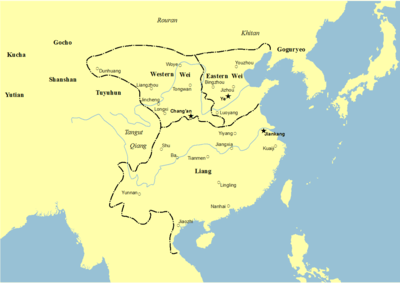Second Chinese domination of Vietnam
| Second Chinese domination of Vietnam Bắc thuộc lần thứ hai (北屬吝次二) | |||||||||
|---|---|---|---|---|---|---|---|---|---|
| 43–544 | |||||||||
 Map of the Liang dynasty in 502 | |||||||||
| Status | District of the Eastern Han dynasty- Eastern Wu-Jin dynasty-Liang dynasty | ||||||||
| Capital | Jiaozhi (Vietnamese: Giao Chỉ) | ||||||||
| Common languages | Old Chinese | ||||||||
| Government | Monarchy | ||||||||
| Emperor | |||||||||
• 43-57 | Emperor Guangwu of Han (First) | ||||||||
• 229-252 | Sun Quan of Eastern Wu | ||||||||
• 266-290 | Emperor Wu of Jin | ||||||||
• 420-422 | Emperor Wu of Liu Song | ||||||||
• 479-482 | Emperor Gao of Southern Qi | ||||||||
• 502–544 | Emperor Wu of Liang (Last) | ||||||||
| History | |||||||||
• Eastern Han-Trưng Sisters war | 43 | ||||||||
• Collapse of Han Dynasty | 220 43 | ||||||||
| 222 | |||||||||
• Jin dynasty unified China | 265 | ||||||||
| 420 | |||||||||
| 479 | |||||||||
| 502 | |||||||||
| 544 544 | |||||||||
| Currency | cash coins | ||||||||
| |||||||||
| Today part of |
| ||||||||
The second Chinese domination marks a period from 43 to 544 when Vietnam fell into Chinese control for a second time, between the end of the Trưng Sisters and the start of the Anterior Lý Dynasty. This period began when General Ma Yuan conquered Giao Chỉ from the Trưng Sisters on the order of emperor Wu of Han. This region was merged again into the Han dynasty, until civil war in China made it unstable and it became divided into many kingdoms. When the Liang dynasty was established, Lý Bí raised a revolt against them and established the Early Lý dynasty. This period lasted about 500 years.
Fluctuations through seven dynasties

The end of Eastern Han dynasty
The Trung sisters' independent rule was one of the few relatively brief interruptions during the Chinese domination of Vietnam which continued from 111 BC to 939.
After the defeat of the Trung sisters, the Eastern Han dynasty strengthened its control over the region in 43 and renamed it Giao Chỉ (or Jiaozhi). As the Han dynasty weakened, the prefect of Giao Chỉ, Shi Xie, ruled Vietnam as an autonomous warlord and was posthumously deified by later Vietnamese Emperors.[1]
Three Kingdoms eras
Even when the Eastern Han dynasty split into the Three Kingdoms in 220, Vietnam remained under the control of the state of Wu. A female rebel named Triệu Thị Trinh briefly pushed the Chinese rulers out in 248, but was soon overthrown. Then Vietnam was under Jin China and the first half of the Southern and Northern Dynasties. The domination ended by 544, when Lý Nam Đế came to power.[2]
Uprisings
Local rebellions were organized by:
References
Bibliography
- Taylor, Keith Weller. (1983). The Birth of Vietnam (illustrated, reprint ed.). University of California Press. ISBN 0520074173. Retrieved 7 August 2013.
- Vietnam
| Preceded by Trưng Sisters |
Dynasty of Vietnam 43–544 |
Succeeded by Anterior Lý Dynasty |
